MREGC5001 Report: Terotechnology and Lifecycle Cost Analysis
VerifiedAdded on 2023/03/21
|14
|2223
|77
Report
AI Summary
This report delves into the concepts of Terotechnology and asset lifecycle costs, crucial for capital investment decisions. It begins with an executive summary explaining Terotechnology's role in analyzing asset costs and benefits, from initial investment to dismantling. The introduction emphasizes the importance of investment analysis in long-term capital assets, focusing on cost-benefit balance. The report then defines Terotechnology and asset lifecycle costs, highlighting their significance in evaluating investment opportunities. A case study of Scorpion Minerals Limited provides real-world data and context, examining gaps in lifecycle costing and offering recommendations for successful asset investment. The report includes detailed answers to practical questions, calculating present worth, annual worth, and internal rate of return (IRR) for different degrees of automation. The conclusion reinforces the importance of comprehensive cost-benefit analysis before investing in capital assets, providing insights for optimizing investment strategies within the mining sector and other capital-intensive industries.
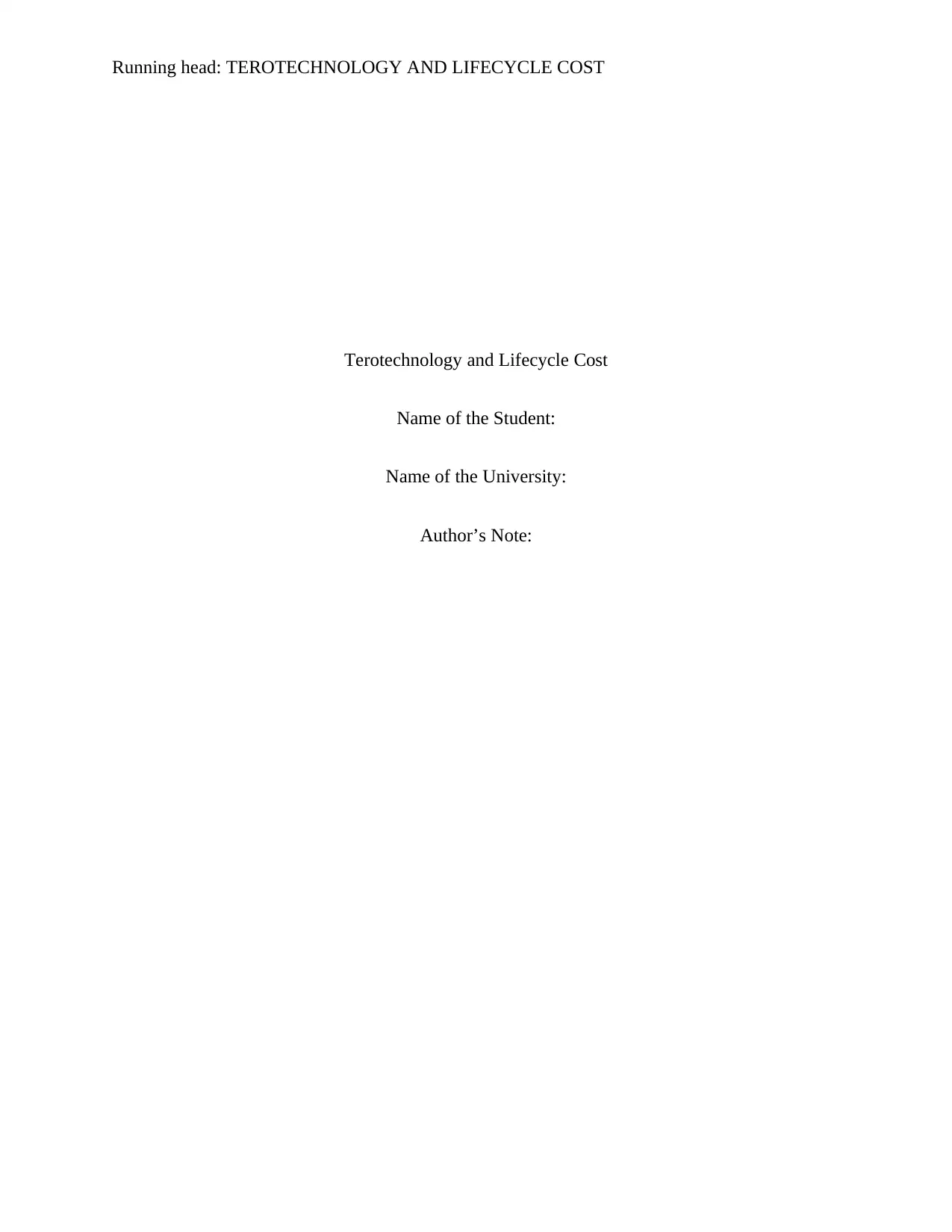
Running head: TEROTECHNOLOGY AND LIFECYCLE COST
Terotechnology and Lifecycle Cost
Name of the Student:
Name of the University:
Author’s Note:
Terotechnology and Lifecycle Cost
Name of the Student:
Name of the University:
Author’s Note:
Paraphrase This Document
Need a fresh take? Get an instant paraphrase of this document with our AI Paraphraser
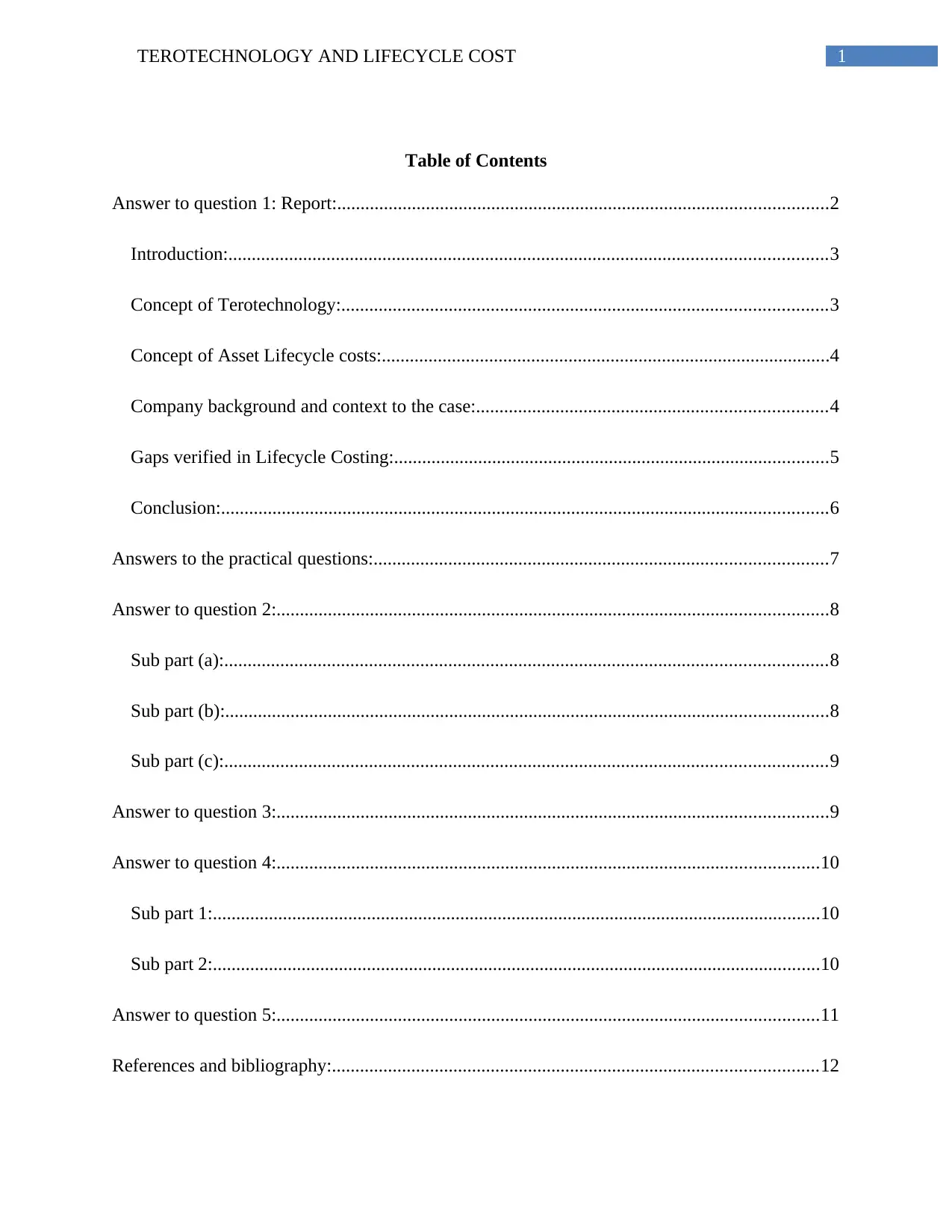
1TEROTECHNOLOGY AND LIFECYCLE COST
Table of Contents
Answer to question 1: Report:.........................................................................................................2
Introduction:................................................................................................................................3
Concept of Terotechnology:........................................................................................................3
Concept of Asset Lifecycle costs:................................................................................................4
Company background and context to the case:...........................................................................4
Gaps verified in Lifecycle Costing:.............................................................................................5
Conclusion:..................................................................................................................................6
Answers to the practical questions:.................................................................................................7
Answer to question 2:......................................................................................................................8
Sub part (a):.................................................................................................................................8
Sub part (b):.................................................................................................................................8
Sub part (c):.................................................................................................................................9
Answer to question 3:......................................................................................................................9
Answer to question 4:....................................................................................................................10
Sub part 1:..................................................................................................................................10
Sub part 2:..................................................................................................................................10
Answer to question 5:....................................................................................................................11
References and bibliography:........................................................................................................12
Table of Contents
Answer to question 1: Report:.........................................................................................................2
Introduction:................................................................................................................................3
Concept of Terotechnology:........................................................................................................3
Concept of Asset Lifecycle costs:................................................................................................4
Company background and context to the case:...........................................................................4
Gaps verified in Lifecycle Costing:.............................................................................................5
Conclusion:..................................................................................................................................6
Answers to the practical questions:.................................................................................................7
Answer to question 2:......................................................................................................................8
Sub part (a):.................................................................................................................................8
Sub part (b):.................................................................................................................................8
Sub part (c):.................................................................................................................................9
Answer to question 3:......................................................................................................................9
Answer to question 4:....................................................................................................................10
Sub part 1:..................................................................................................................................10
Sub part 2:..................................................................................................................................10
Answer to question 5:....................................................................................................................11
References and bibliography:........................................................................................................12
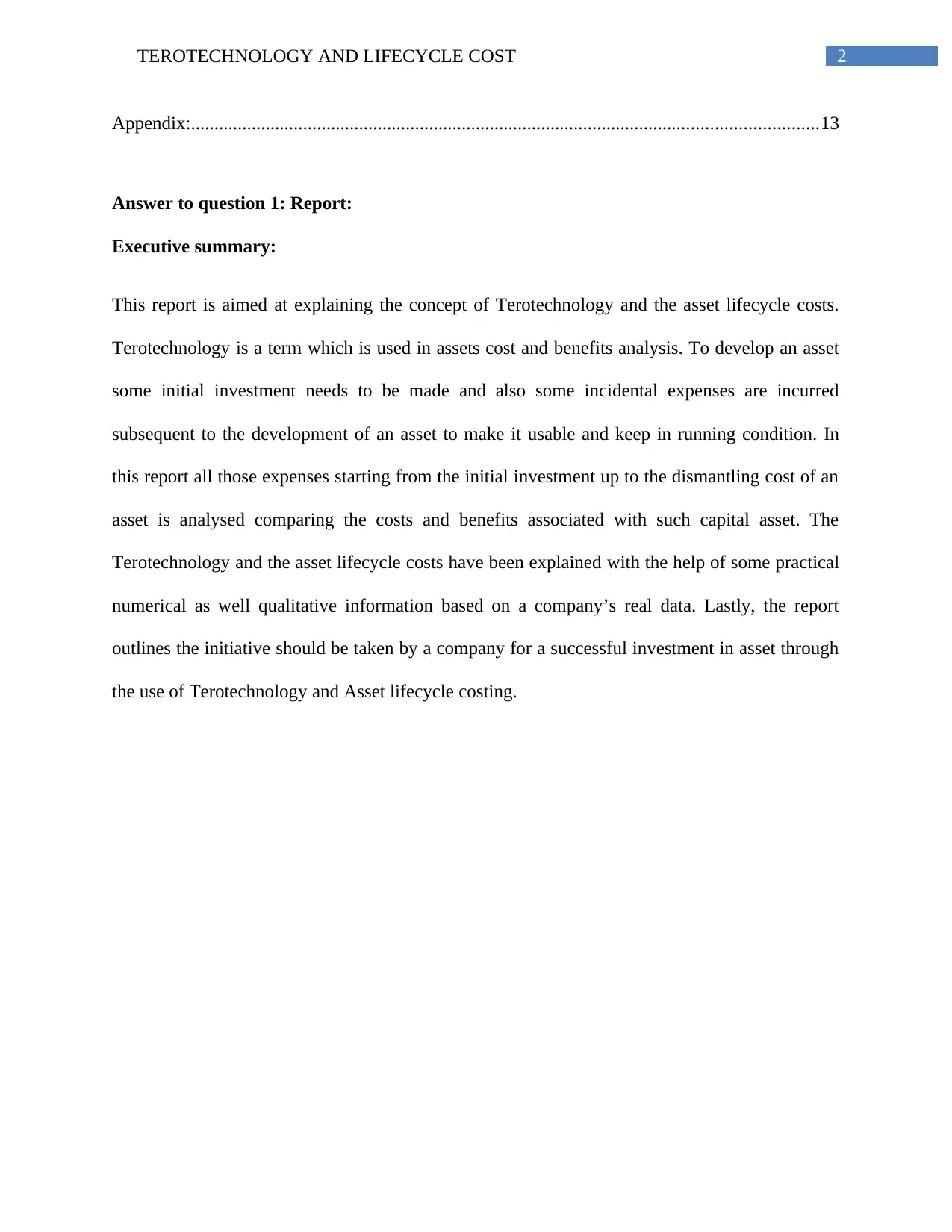
2TEROTECHNOLOGY AND LIFECYCLE COST
Appendix:......................................................................................................................................13
Answer to question 1: Report:
Executive summary:
This report is aimed at explaining the concept of Terotechnology and the asset lifecycle costs.
Terotechnology is a term which is used in assets cost and benefits analysis. To develop an asset
some initial investment needs to be made and also some incidental expenses are incurred
subsequent to the development of an asset to make it usable and keep in running condition. In
this report all those expenses starting from the initial investment up to the dismantling cost of an
asset is analysed comparing the costs and benefits associated with such capital asset. The
Terotechnology and the asset lifecycle costs have been explained with the help of some practical
numerical as well qualitative information based on a company’s real data. Lastly, the report
outlines the initiative should be taken by a company for a successful investment in asset through
the use of Terotechnology and Asset lifecycle costing.
Appendix:......................................................................................................................................13
Answer to question 1: Report:
Executive summary:
This report is aimed at explaining the concept of Terotechnology and the asset lifecycle costs.
Terotechnology is a term which is used in assets cost and benefits analysis. To develop an asset
some initial investment needs to be made and also some incidental expenses are incurred
subsequent to the development of an asset to make it usable and keep in running condition. In
this report all those expenses starting from the initial investment up to the dismantling cost of an
asset is analysed comparing the costs and benefits associated with such capital asset. The
Terotechnology and the asset lifecycle costs have been explained with the help of some practical
numerical as well qualitative information based on a company’s real data. Lastly, the report
outlines the initiative should be taken by a company for a successful investment in asset through
the use of Terotechnology and Asset lifecycle costing.
⊘ This is a preview!⊘
Do you want full access?
Subscribe today to unlock all pages.

Trusted by 1+ million students worldwide
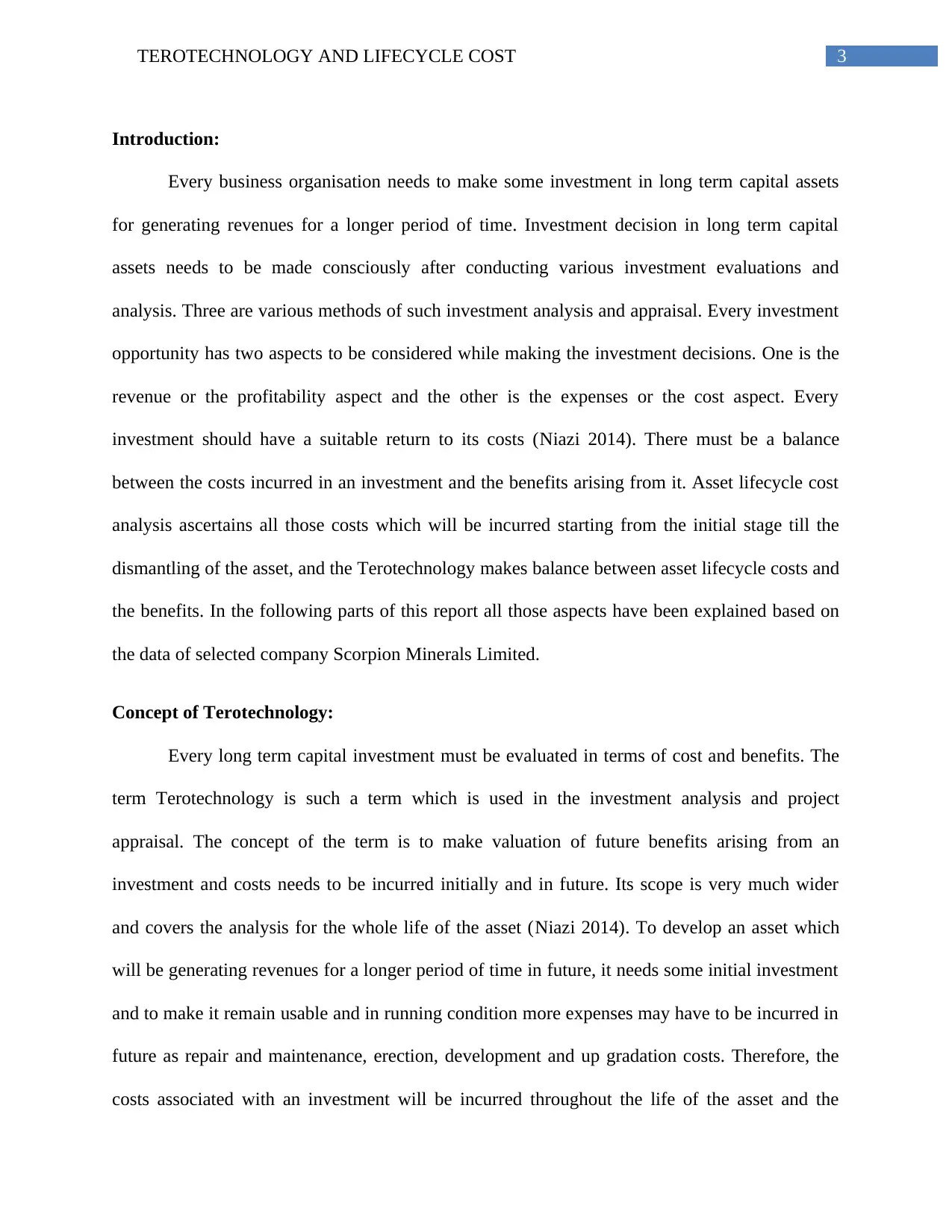
3TEROTECHNOLOGY AND LIFECYCLE COST
Introduction:
Every business organisation needs to make some investment in long term capital assets
for generating revenues for a longer period of time. Investment decision in long term capital
assets needs to be made consciously after conducting various investment evaluations and
analysis. Three are various methods of such investment analysis and appraisal. Every investment
opportunity has two aspects to be considered while making the investment decisions. One is the
revenue or the profitability aspect and the other is the expenses or the cost aspect. Every
investment should have a suitable return to its costs (Niazi 2014). There must be a balance
between the costs incurred in an investment and the benefits arising from it. Asset lifecycle cost
analysis ascertains all those costs which will be incurred starting from the initial stage till the
dismantling of the asset, and the Terotechnology makes balance between asset lifecycle costs and
the benefits. In the following parts of this report all those aspects have been explained based on
the data of selected company Scorpion Minerals Limited.
Concept of Terotechnology:
Every long term capital investment must be evaluated in terms of cost and benefits. The
term Terotechnology is such a term which is used in the investment analysis and project
appraisal. The concept of the term is to make valuation of future benefits arising from an
investment and costs needs to be incurred initially and in future. Its scope is very much wider
and covers the analysis for the whole life of the asset (Niazi 2014). To develop an asset which
will be generating revenues for a longer period of time in future, it needs some initial investment
and to make it remain usable and in running condition more expenses may have to be incurred in
future as repair and maintenance, erection, development and up gradation costs. Therefore, the
costs associated with an investment will be incurred throughout the life of the asset and the
Introduction:
Every business organisation needs to make some investment in long term capital assets
for generating revenues for a longer period of time. Investment decision in long term capital
assets needs to be made consciously after conducting various investment evaluations and
analysis. Three are various methods of such investment analysis and appraisal. Every investment
opportunity has two aspects to be considered while making the investment decisions. One is the
revenue or the profitability aspect and the other is the expenses or the cost aspect. Every
investment should have a suitable return to its costs (Niazi 2014). There must be a balance
between the costs incurred in an investment and the benefits arising from it. Asset lifecycle cost
analysis ascertains all those costs which will be incurred starting from the initial stage till the
dismantling of the asset, and the Terotechnology makes balance between asset lifecycle costs and
the benefits. In the following parts of this report all those aspects have been explained based on
the data of selected company Scorpion Minerals Limited.
Concept of Terotechnology:
Every long term capital investment must be evaluated in terms of cost and benefits. The
term Terotechnology is such a term which is used in the investment analysis and project
appraisal. The concept of the term is to make valuation of future benefits arising from an
investment and costs needs to be incurred initially and in future. Its scope is very much wider
and covers the analysis for the whole life of the asset (Niazi 2014). To develop an asset which
will be generating revenues for a longer period of time in future, it needs some initial investment
and to make it remain usable and in running condition more expenses may have to be incurred in
future as repair and maintenance, erection, development and up gradation costs. Therefore, the
costs associated with an investment will be incurred throughout the life of the asset and the
Paraphrase This Document
Need a fresh take? Get an instant paraphrase of this document with our AI Paraphraser
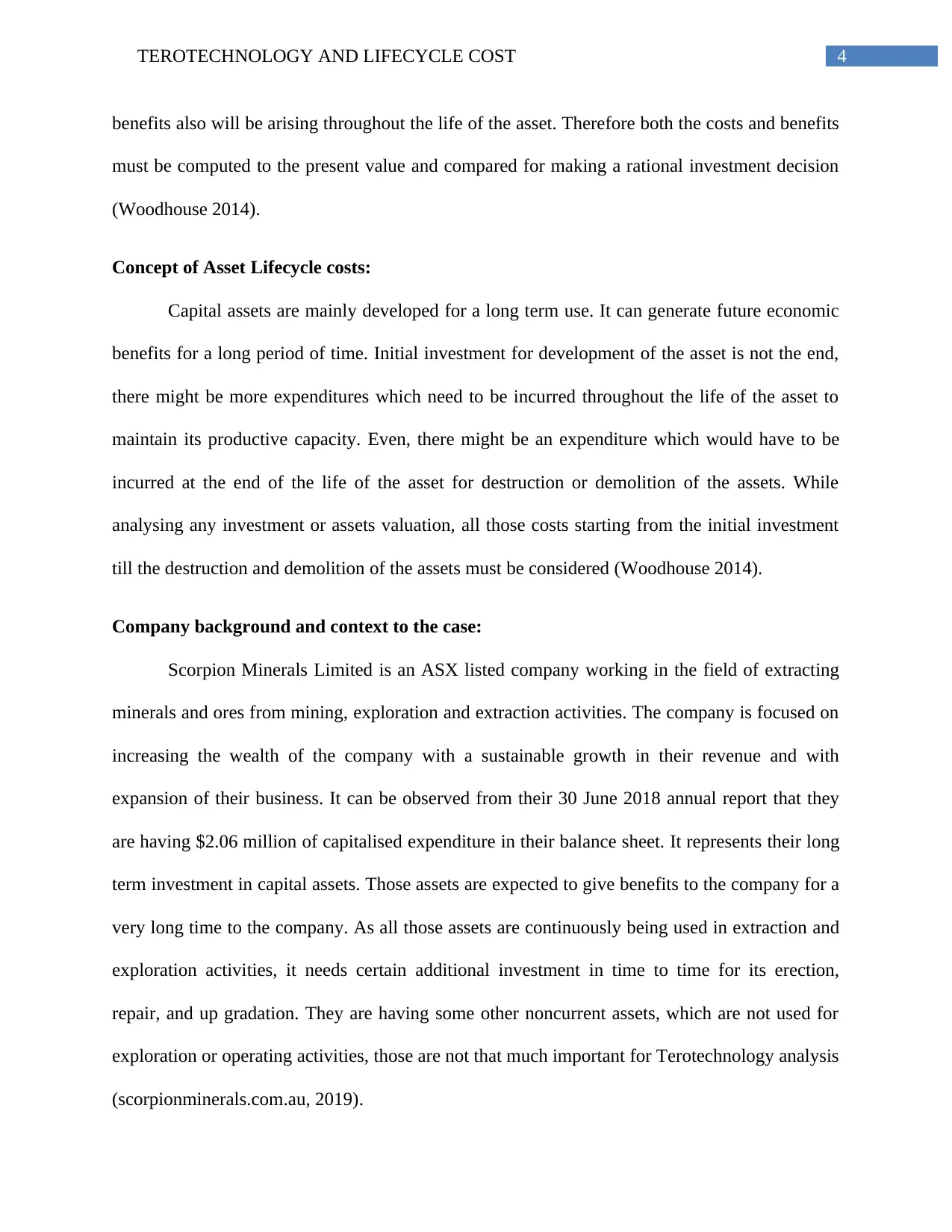
4TEROTECHNOLOGY AND LIFECYCLE COST
benefits also will be arising throughout the life of the asset. Therefore both the costs and benefits
must be computed to the present value and compared for making a rational investment decision
(Woodhouse 2014).
Concept of Asset Lifecycle costs:
Capital assets are mainly developed for a long term use. It can generate future economic
benefits for a long period of time. Initial investment for development of the asset is not the end,
there might be more expenditures which need to be incurred throughout the life of the asset to
maintain its productive capacity. Even, there might be an expenditure which would have to be
incurred at the end of the life of the asset for destruction or demolition of the assets. While
analysing any investment or assets valuation, all those costs starting from the initial investment
till the destruction and demolition of the assets must be considered (Woodhouse 2014).
Company background and context to the case:
Scorpion Minerals Limited is an ASX listed company working in the field of extracting
minerals and ores from mining, exploration and extraction activities. The company is focused on
increasing the wealth of the company with a sustainable growth in their revenue and with
expansion of their business. It can be observed from their 30 June 2018 annual report that they
are having $2.06 million of capitalised expenditure in their balance sheet. It represents their long
term investment in capital assets. Those assets are expected to give benefits to the company for a
very long time to the company. As all those assets are continuously being used in extraction and
exploration activities, it needs certain additional investment in time to time for its erection,
repair, and up gradation. They are having some other noncurrent assets, which are not used for
exploration or operating activities, those are not that much important for Terotechnology analysis
(scorpionminerals.com.au, 2019).
benefits also will be arising throughout the life of the asset. Therefore both the costs and benefits
must be computed to the present value and compared for making a rational investment decision
(Woodhouse 2014).
Concept of Asset Lifecycle costs:
Capital assets are mainly developed for a long term use. It can generate future economic
benefits for a long period of time. Initial investment for development of the asset is not the end,
there might be more expenditures which need to be incurred throughout the life of the asset to
maintain its productive capacity. Even, there might be an expenditure which would have to be
incurred at the end of the life of the asset for destruction or demolition of the assets. While
analysing any investment or assets valuation, all those costs starting from the initial investment
till the destruction and demolition of the assets must be considered (Woodhouse 2014).
Company background and context to the case:
Scorpion Minerals Limited is an ASX listed company working in the field of extracting
minerals and ores from mining, exploration and extraction activities. The company is focused on
increasing the wealth of the company with a sustainable growth in their revenue and with
expansion of their business. It can be observed from their 30 June 2018 annual report that they
are having $2.06 million of capitalised expenditure in their balance sheet. It represents their long
term investment in capital assets. Those assets are expected to give benefits to the company for a
very long time to the company. As all those assets are continuously being used in extraction and
exploration activities, it needs certain additional investment in time to time for its erection,
repair, and up gradation. They are having some other noncurrent assets, which are not used for
exploration or operating activities, those are not that much important for Terotechnology analysis
(scorpionminerals.com.au, 2019).
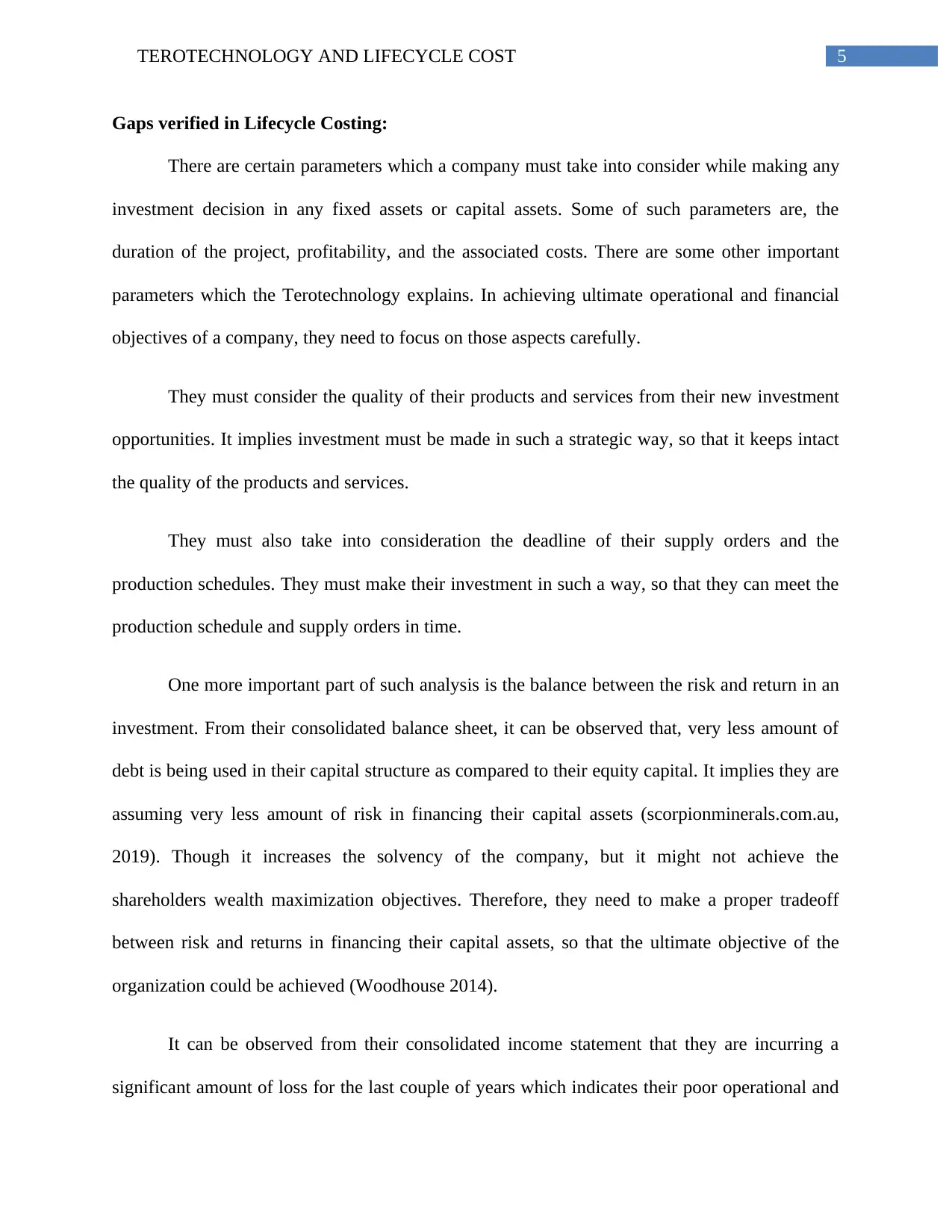
5TEROTECHNOLOGY AND LIFECYCLE COST
Gaps verified in Lifecycle Costing:
There are certain parameters which a company must take into consider while making any
investment decision in any fixed assets or capital assets. Some of such parameters are, the
duration of the project, profitability, and the associated costs. There are some other important
parameters which the Terotechnology explains. In achieving ultimate operational and financial
objectives of a company, they need to focus on those aspects carefully.
They must consider the quality of their products and services from their new investment
opportunities. It implies investment must be made in such a strategic way, so that it keeps intact
the quality of the products and services.
They must also take into consideration the deadline of their supply orders and the
production schedules. They must make their investment in such a way, so that they can meet the
production schedule and supply orders in time.
One more important part of such analysis is the balance between the risk and return in an
investment. From their consolidated balance sheet, it can be observed that, very less amount of
debt is being used in their capital structure as compared to their equity capital. It implies they are
assuming very less amount of risk in financing their capital assets (scorpionminerals.com.au,
2019). Though it increases the solvency of the company, but it might not achieve the
shareholders wealth maximization objectives. Therefore, they need to make a proper tradeoff
between risk and returns in financing their capital assets, so that the ultimate objective of the
organization could be achieved (Woodhouse 2014).
It can be observed from their consolidated income statement that they are incurring a
significant amount of loss for the last couple of years which indicates their poor operational and
Gaps verified in Lifecycle Costing:
There are certain parameters which a company must take into consider while making any
investment decision in any fixed assets or capital assets. Some of such parameters are, the
duration of the project, profitability, and the associated costs. There are some other important
parameters which the Terotechnology explains. In achieving ultimate operational and financial
objectives of a company, they need to focus on those aspects carefully.
They must consider the quality of their products and services from their new investment
opportunities. It implies investment must be made in such a strategic way, so that it keeps intact
the quality of the products and services.
They must also take into consideration the deadline of their supply orders and the
production schedules. They must make their investment in such a way, so that they can meet the
production schedule and supply orders in time.
One more important part of such analysis is the balance between the risk and return in an
investment. From their consolidated balance sheet, it can be observed that, very less amount of
debt is being used in their capital structure as compared to their equity capital. It implies they are
assuming very less amount of risk in financing their capital assets (scorpionminerals.com.au,
2019). Though it increases the solvency of the company, but it might not achieve the
shareholders wealth maximization objectives. Therefore, they need to make a proper tradeoff
between risk and returns in financing their capital assets, so that the ultimate objective of the
organization could be achieved (Woodhouse 2014).
It can be observed from their consolidated income statement that they are incurring a
significant amount of loss for the last couple of years which indicates their poor operational and
⊘ This is a preview!⊘
Do you want full access?
Subscribe today to unlock all pages.

Trusted by 1+ million students worldwide
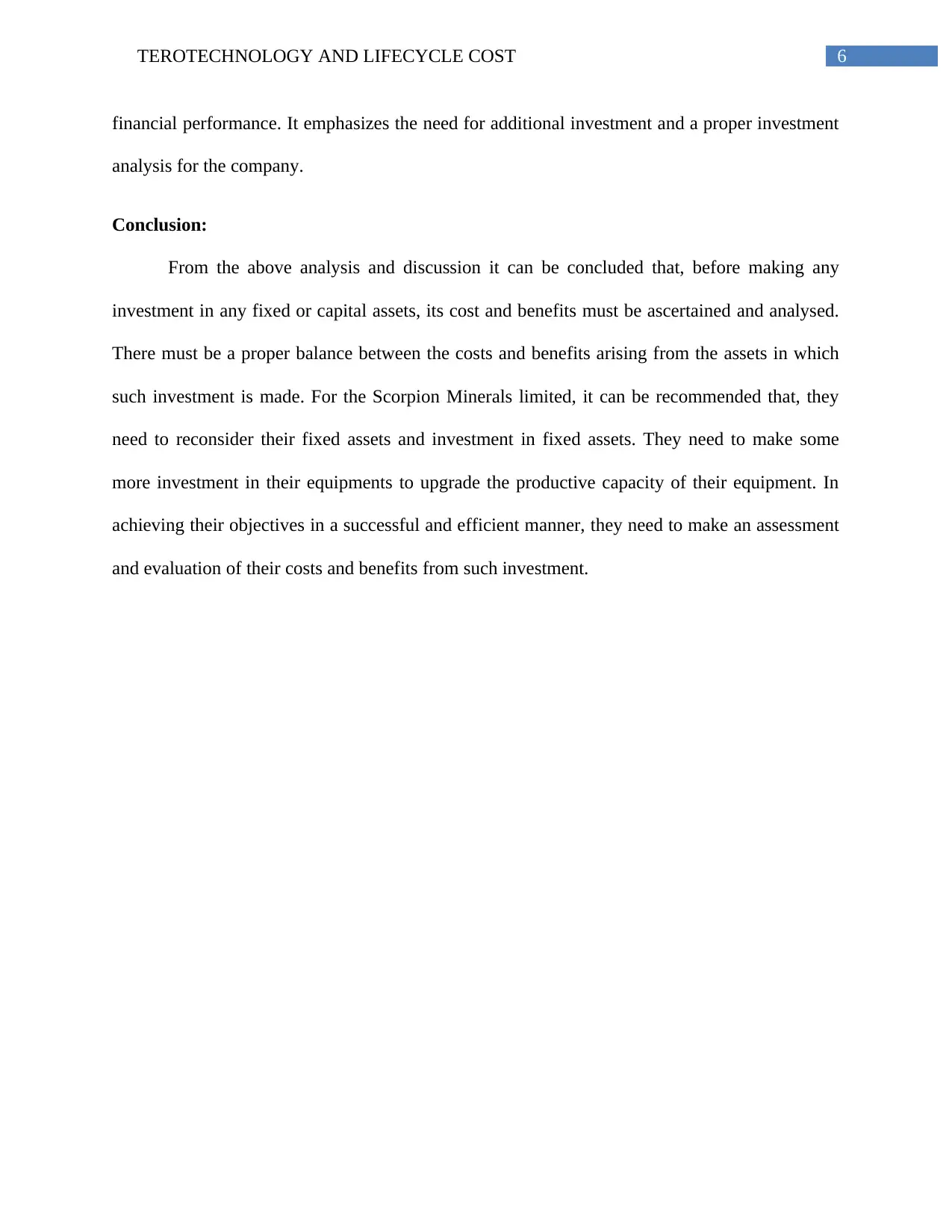
6TEROTECHNOLOGY AND LIFECYCLE COST
financial performance. It emphasizes the need for additional investment and a proper investment
analysis for the company.
Conclusion:
From the above analysis and discussion it can be concluded that, before making any
investment in any fixed or capital assets, its cost and benefits must be ascertained and analysed.
There must be a proper balance between the costs and benefits arising from the assets in which
such investment is made. For the Scorpion Minerals limited, it can be recommended that, they
need to reconsider their fixed assets and investment in fixed assets. They need to make some
more investment in their equipments to upgrade the productive capacity of their equipment. In
achieving their objectives in a successful and efficient manner, they need to make an assessment
and evaluation of their costs and benefits from such investment.
financial performance. It emphasizes the need for additional investment and a proper investment
analysis for the company.
Conclusion:
From the above analysis and discussion it can be concluded that, before making any
investment in any fixed or capital assets, its cost and benefits must be ascertained and analysed.
There must be a proper balance between the costs and benefits arising from the assets in which
such investment is made. For the Scorpion Minerals limited, it can be recommended that, they
need to reconsider their fixed assets and investment in fixed assets. They need to make some
more investment in their equipments to upgrade the productive capacity of their equipment. In
achieving their objectives in a successful and efficient manner, they need to make an assessment
and evaluation of their costs and benefits from such investment.
Paraphrase This Document
Need a fresh take? Get an instant paraphrase of this document with our AI Paraphraser
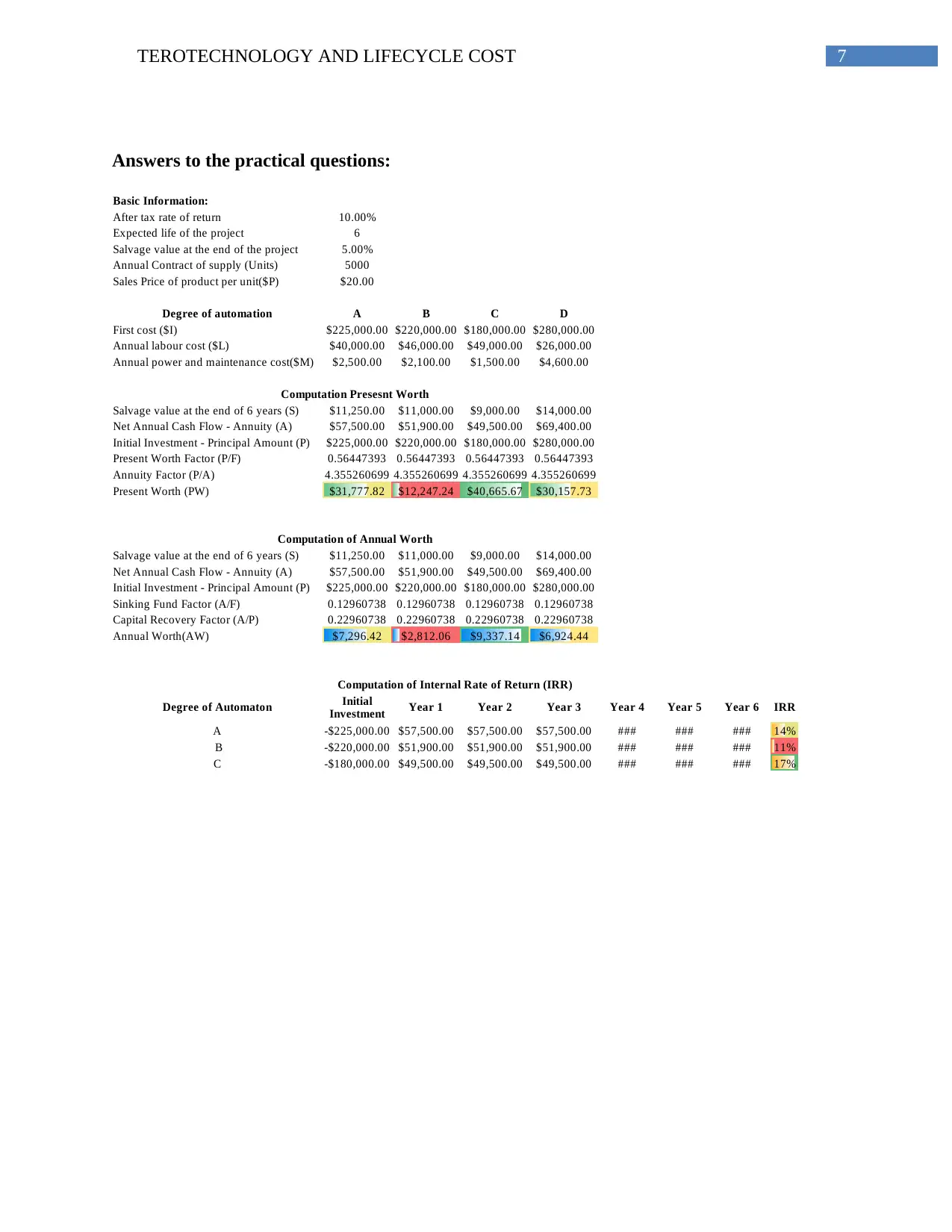
7TEROTECHNOLOGY AND LIFECYCLE COST
Answers to the practical questions:
Basic Information:
After tax rate of return 10.00%
Expected life of the project 6
Salvage value at the end of the project 5.00%
Annual Contract of supply (Units) 5000
Sales Price of product per unit($P) $20.00
Degree of automation A B C D
First cost ($I) $225,000.00 $220,000.00 $180,000.00 $280,000.00
Annual labour cost ($L) $40,000.00 $46,000.00 $49,000.00 $26,000.00
Annual power and maintenance cost($M) $2,500.00 $2,100.00 $1,500.00 $4,600.00
Computation Presesnt Worth
Salvage value at the end of 6 years (S) $11,250.00 $11,000.00 $9,000.00 $14,000.00
Net Annual Cash Flow - Annuity (A) $57,500.00 $51,900.00 $49,500.00 $69,400.00
Initial Investment - Principal Amount (P) $225,000.00 $220,000.00 $180,000.00 $280,000.00
Present Worth Factor (P/F) 0.56447393 0.56447393 0.56447393 0.56447393
Annuity Factor (P/A) 4.355260699 4.355260699 4.355260699 4.355260699
Present Worth (PW) $31,777.82 $12,247.24 $40,665.67 $30,157.73
Computation of Annual Worth
Salvage value at the end of 6 years (S) $11,250.00 $11,000.00 $9,000.00 $14,000.00
Net Annual Cash Flow - Annuity (A) $57,500.00 $51,900.00 $49,500.00 $69,400.00
Initial Investment - Principal Amount (P) $225,000.00 $220,000.00 $180,000.00 $280,000.00
Sinking Fund Factor (A/F) 0.12960738 0.12960738 0.12960738 0.12960738
Capital Recovery Factor (A/P) 0.22960738 0.22960738 0.22960738 0.22960738
Annual Worth(AW) $7,296.42 $2,812.06 $9,337.14 $6,924.44
Computation of Internal Rate of Return (IRR)
Degree of Automaton Year 1 Year 2 Year 3 Year 4 Year 5 Year 6 IRR
A -$225,000.00 $57,500.00 $57,500.00 $57,500.00 ### ### ### 14%
B -$220,000.00 $51,900.00 $51,900.00 $51,900.00 ### ### ### 11%
C -$180,000.00 $49,500.00 $49,500.00 $49,500.00 ### ### ### 17%
Initial
Investment
Answers to the practical questions:
Basic Information:
After tax rate of return 10.00%
Expected life of the project 6
Salvage value at the end of the project 5.00%
Annual Contract of supply (Units) 5000
Sales Price of product per unit($P) $20.00
Degree of automation A B C D
First cost ($I) $225,000.00 $220,000.00 $180,000.00 $280,000.00
Annual labour cost ($L) $40,000.00 $46,000.00 $49,000.00 $26,000.00
Annual power and maintenance cost($M) $2,500.00 $2,100.00 $1,500.00 $4,600.00
Computation Presesnt Worth
Salvage value at the end of 6 years (S) $11,250.00 $11,000.00 $9,000.00 $14,000.00
Net Annual Cash Flow - Annuity (A) $57,500.00 $51,900.00 $49,500.00 $69,400.00
Initial Investment - Principal Amount (P) $225,000.00 $220,000.00 $180,000.00 $280,000.00
Present Worth Factor (P/F) 0.56447393 0.56447393 0.56447393 0.56447393
Annuity Factor (P/A) 4.355260699 4.355260699 4.355260699 4.355260699
Present Worth (PW) $31,777.82 $12,247.24 $40,665.67 $30,157.73
Computation of Annual Worth
Salvage value at the end of 6 years (S) $11,250.00 $11,000.00 $9,000.00 $14,000.00
Net Annual Cash Flow - Annuity (A) $57,500.00 $51,900.00 $49,500.00 $69,400.00
Initial Investment - Principal Amount (P) $225,000.00 $220,000.00 $180,000.00 $280,000.00
Sinking Fund Factor (A/F) 0.12960738 0.12960738 0.12960738 0.12960738
Capital Recovery Factor (A/P) 0.22960738 0.22960738 0.22960738 0.22960738
Annual Worth(AW) $7,296.42 $2,812.06 $9,337.14 $6,924.44
Computation of Internal Rate of Return (IRR)
Degree of Automaton Year 1 Year 2 Year 3 Year 4 Year 5 Year 6 IRR
A -$225,000.00 $57,500.00 $57,500.00 $57,500.00 ### ### ### 14%
B -$220,000.00 $51,900.00 $51,900.00 $51,900.00 ### ### ### 11%
C -$180,000.00 $49,500.00 $49,500.00 $49,500.00 ### ### ### 17%
Initial
Investment
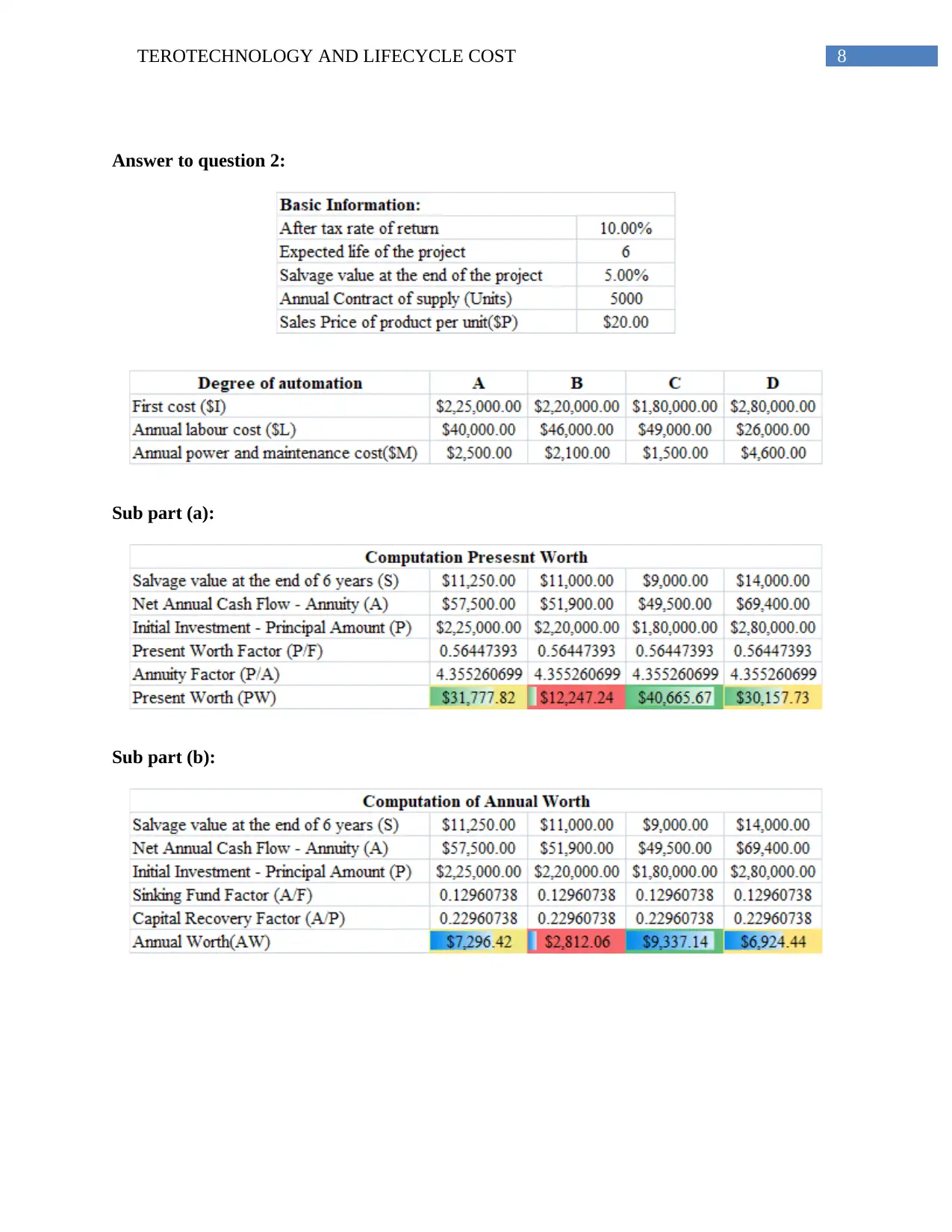
8TEROTECHNOLOGY AND LIFECYCLE COST
Answer to question 2:
Sub part (a):
Sub part (b):
Answer to question 2:
Sub part (a):
Sub part (b):
⊘ This is a preview!⊘
Do you want full access?
Subscribe today to unlock all pages.

Trusted by 1+ million students worldwide
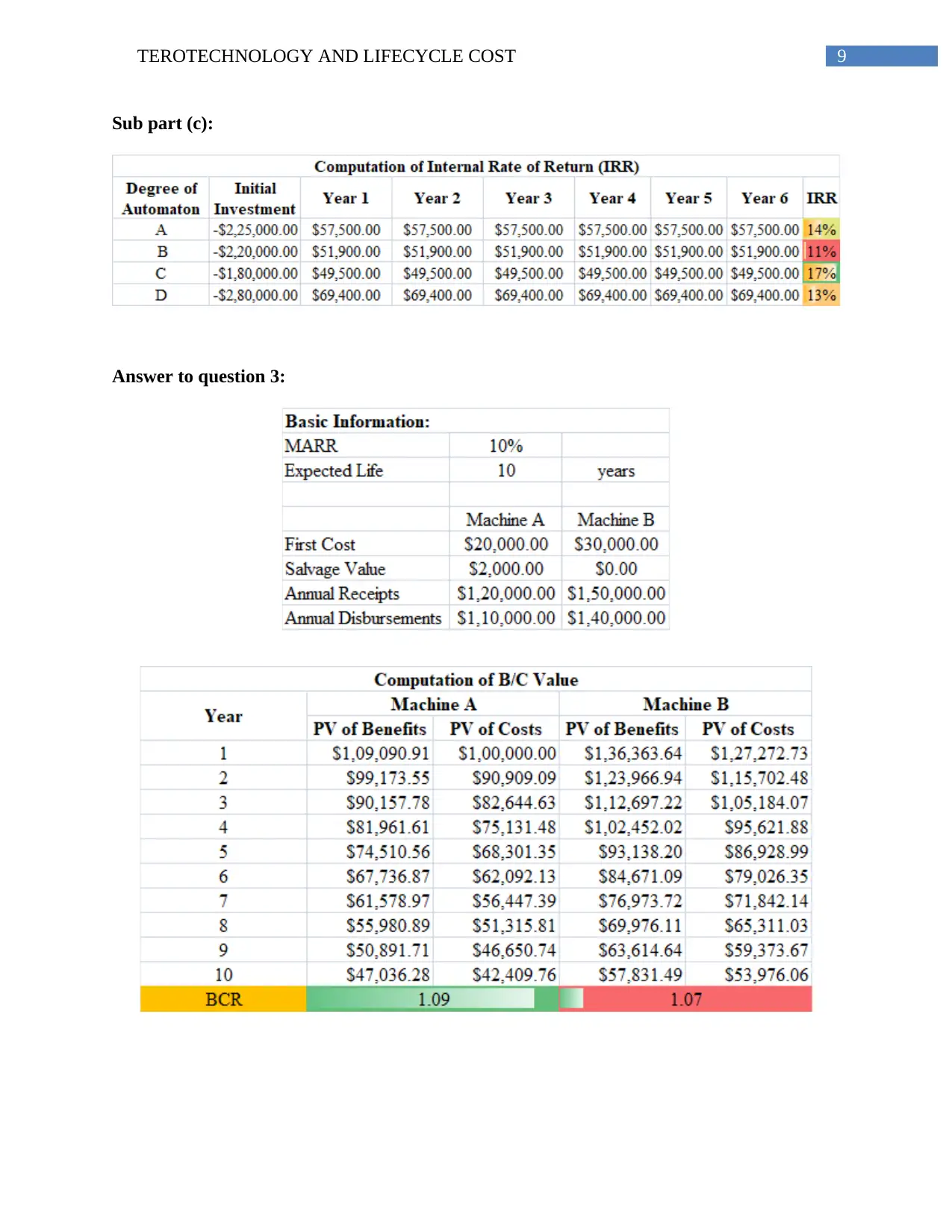
9TEROTECHNOLOGY AND LIFECYCLE COST
Sub part (c):
Answer to question 3:
Sub part (c):
Answer to question 3:
Paraphrase This Document
Need a fresh take? Get an instant paraphrase of this document with our AI Paraphraser
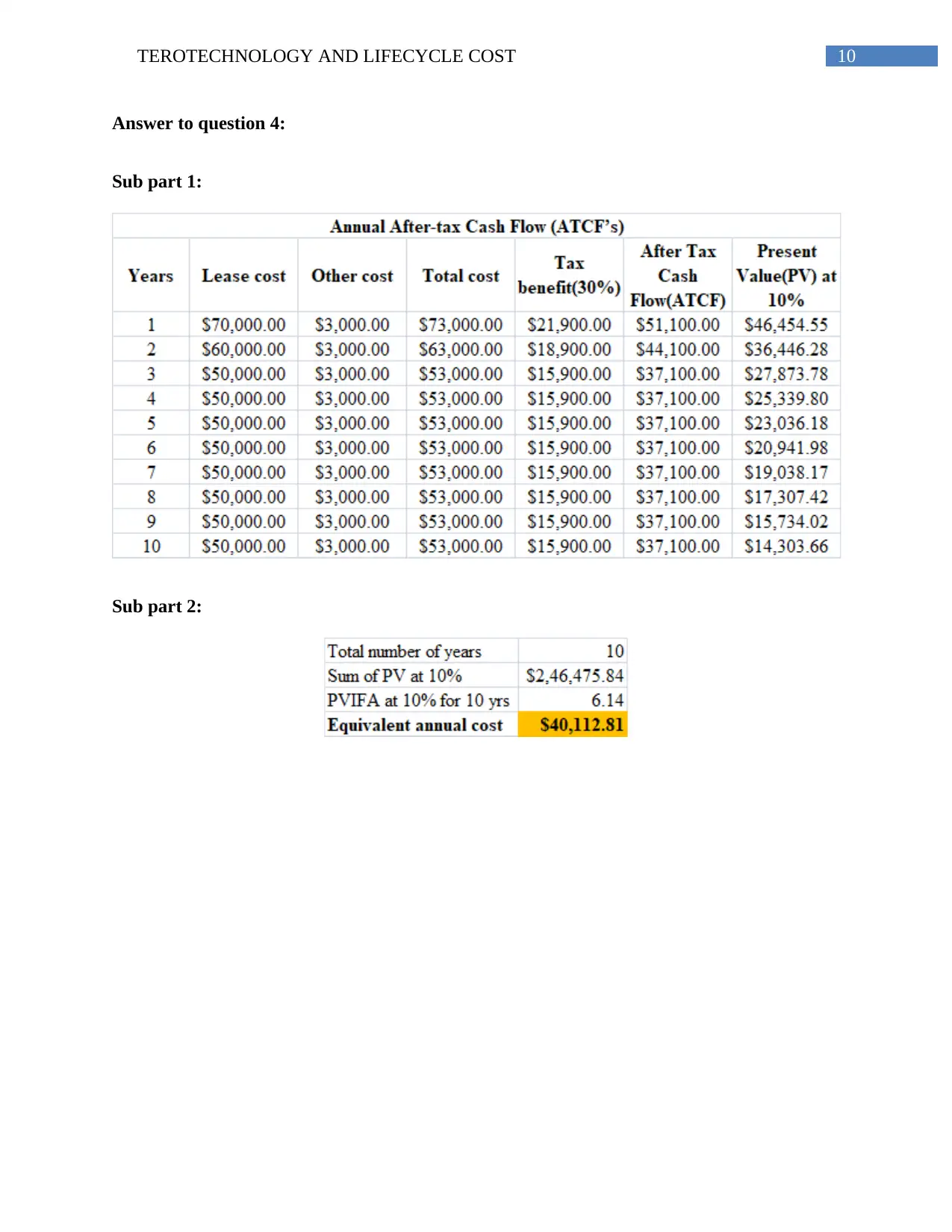
10TEROTECHNOLOGY AND LIFECYCLE COST
Answer to question 4:
Sub part 1:
Sub part 2:
Answer to question 4:
Sub part 1:
Sub part 2:
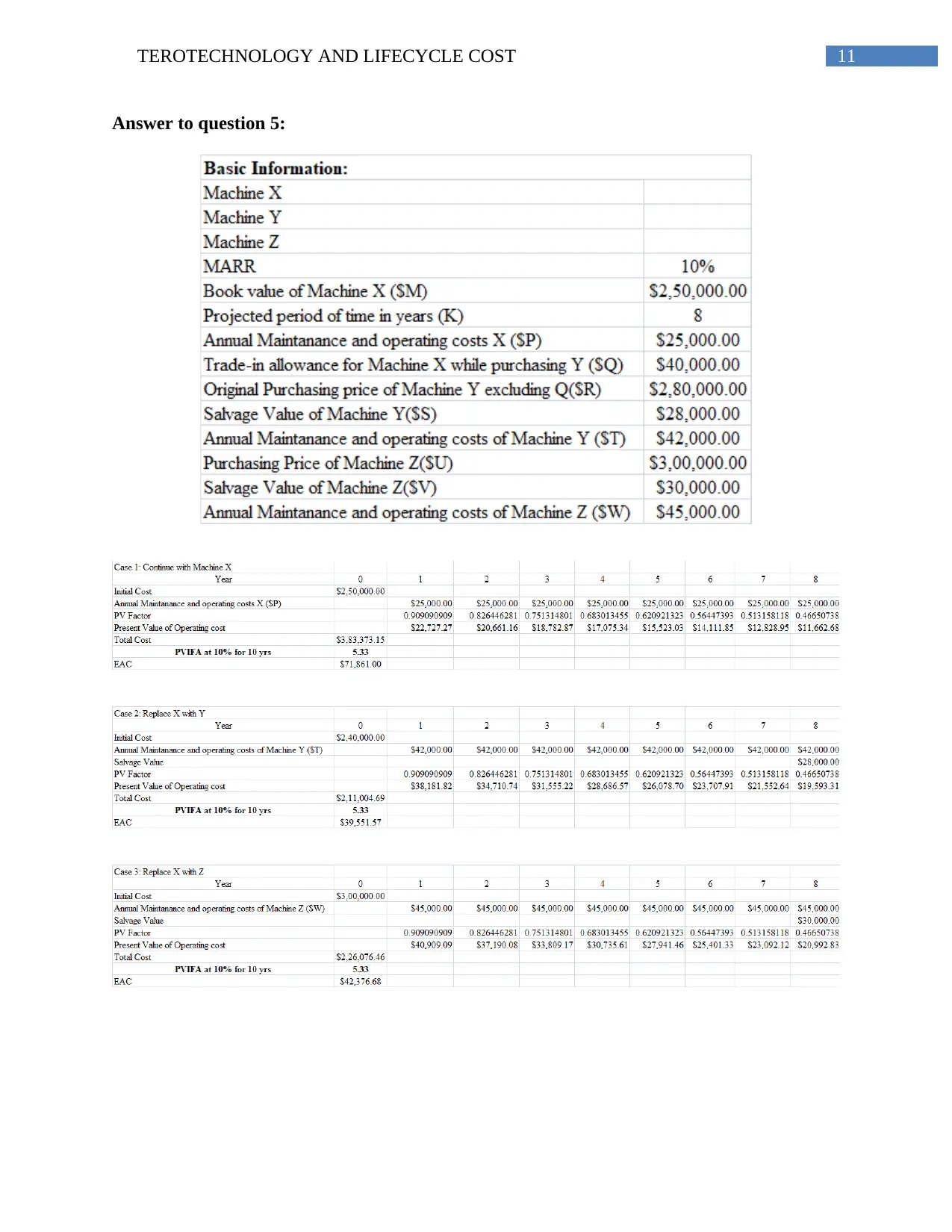
11TEROTECHNOLOGY AND LIFECYCLE COST
Answer to question 5:
Answer to question 5:
⊘ This is a preview!⊘
Do you want full access?
Subscribe today to unlock all pages.

Trusted by 1+ million students worldwide
1 out of 14
Related Documents
Your All-in-One AI-Powered Toolkit for Academic Success.
+13062052269
info@desklib.com
Available 24*7 on WhatsApp / Email
![[object Object]](/_next/static/media/star-bottom.7253800d.svg)
Unlock your academic potential
Copyright © 2020–2025 A2Z Services. All Rights Reserved. Developed and managed by ZUCOL.




